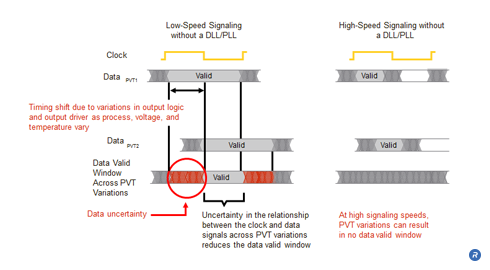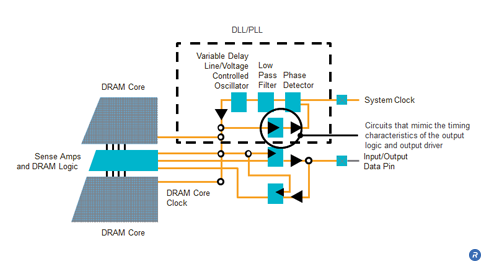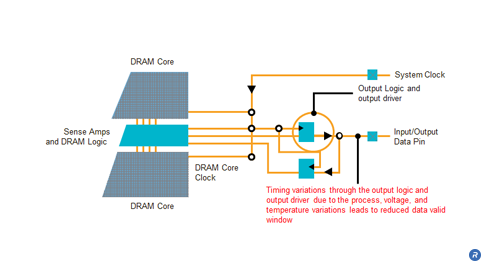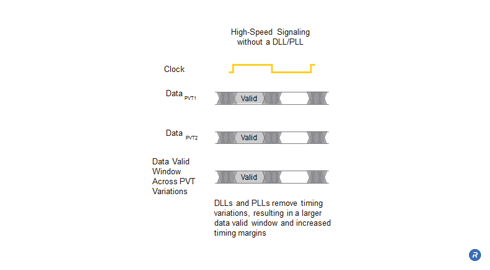As CPU speeds continue to increase, memory performance becomes more of a limiting factor in system performance. For system performance to increase, memory performance must increase as well. An important aspect of increasing memory performance is increasing the speed at which data can be transmitted to and from the DRAMs in the memory system. In the early 1990s, Rambus designed the first DRAMs that incorporated DLLs and PLLs, important innovations that allowed DRAMs to achieve 500 MHz signaling rates, more than eight times faster than the prevailing DRAM communication rates at the time.
- Maximizes operating frequency of a memory system
- Increases DRAM performance
- Improves DRAM yield and reduced production costs
What is DLL/PLL on a DRAM Technology?

Modern systems use synchronous communication to achieve high data transmission rates to and from the DRAMs in the memory system. Systems that communicate synchronously use a clock signal as a timing reference so that data can be transmitted and received with a known relationship to this reference. A difficulty in maintaining this relationship is that process, voltage, and temperature variations can alter the timing relationship between the clock and data signals, resulting in reduced timing margins. This problem gets worse as signaling speeds increase, limiting the ability of systems to communicate data at higher speeds.
Timing margins, in particular, can be affected by process, voltage, and temperature at low and high signaling speeds. At low signaling speeds (the left side of Figure 1), DataPVT1 illustrates the relationship of the data valid window (the time over which data can be reliably sampled by the receiver) and the clock for a given set of operating conditions. Likewise, DataPVT2 shows the relationship of the data valid window and the clock for a different set of operating conditions. These two sets of operating conditions represent the operational extremes over which the device functions. Receiver circuitry does not typically understand how the data valid window changes as process, voltage, and temperature change at the transmitter. Because of this, the receiver circuitry is designed to sample data within a window of time that data is valid across all allowed operating conditions. If DataPVT1 and DataPVT2 represent the soonest and latest (relative to the clock signal) data valid windows, then the receiver will assume a data valid window that is the intersection of these two, and choose a sample point within this resulting data valid window that is valid across process, voltage, and temperature variations.
At low signaling speeds, the data valid window (the time over which data can be sampled reliably by the receiver) can be large. Even in the presence of a substantial shift in the data valid window across operational extremes, the resulting data valid window can still be large enough to transmit and receive data reliably. This is the case for DRAM technologies such as SDRAM. However, for higher-speed DRAM technologies such as RDRAM and DDR, variations in process, voltage, and temperature can result in the loss of the data valid window. The right side of Figure 1 shows that at higher signaling speeds, the data valid windows for both DataPVT1 and DataPVT2 are smaller, reflecting the fact that information must be transmitted more quickly at higher signaling rates. Although the data valid windows are smaller, these windows still shift the same amount across process, voltage, and temperature (assuming no manufacturing improvements or changes in operating environment). Because these data valid windows are smaller, the resulting intersection of the data valid windows yields no resulting data valid window during which receiver circuitry can reliably sample data.
As process, voltage, and temperature vary, the timing characteristics of the output logic and output driver change, causing the data valid window to shift. In order to transmit and receive data at high speeds, this timing variation needs to be addressed.

Delay Lock Loops (DLLs) and Phase Lock Loops (PLLs) serve similar purposes, and can be used to maintain a fixed timing relationship between signals in environments where process, voltage, and temperature variations cause these relationships to change over time. DLLs and PLLs work by continuously comparing the relationship between two signals and providing feedback to adjust and maintain a fixed relationship between them. Rambus DRAMs were the first DRAMs to incorporate DLLs and PLLs, an important innovation that resulted in increased signaling speeds, compared to alternative DRAM technologies.

A DLL is used to maintain the timing relationship between a clock signal and an output data signal. A critical element of the DLL is the phase detector, which detects phase differences between the clock and output data. The phase detector detects this phase difference, and sends control information through a low pass filter to a variable delay line that adjusts the timing of the internal clock to maintain the desired timing relationship (PLLs use a voltage controlled oscillator to adjust this timing relationship). One of the difficulties of maintaining phase relationships between these two signals is that the loop which provides feedback to the phase detector must account for the timing characteristics of the output logic and output driver. This is important, as it estimates the phase differences between the clock and the data being driven by the output driver. In order to accomplish this, circuits that mimic the behavioral characteristics of the output logic and output driver are inserted into this feedback loop to model timing delays and changes in behavior as process, voltage, and temperature vary. Maintaining the timing relationships between the clock and output data in this manner with DLLs and PLLs results in improved timing margins (as shown in Figure 4), and addresses an important limitation to increasing signaling speeds.
PLLs are similar to DLLs, but can also be used to divide-down or multiply-up an external system clock frequency for use in other parts of a chip. PLLs can be used to provide a slower clock frequency to the core of a DRAM, while the interface operates at a higher clock frequency. PLLs used in this manner enable DRAM core prefetch, allowing the DRAM core to operate at a slower frequency (improving DRAM yield), while allowing the interface to run at higher speeds to improve system performance.

In 1993 Rambus published details of a 500 MHz PLL design at the International Solid State Circuits Conference (ISSCC), the premier conference on circuit design. One year later, Rambus published details of a 500 MHz DLL in a paper presented at ISSCC in 1994. Both papers received prestigious Best Paper awards in recognition of the groundbreaking innovations described in each.
Who Benefits?
End Users, DRAM manufacturers, designers and integrators can all benefit by incorporating a DLL/PLL on a DRAM. By providing a fixed timing relationship between clock and data signals, DRAM performance is allowed to increase and end users are able to benefit from the overall improvement in system performance. DRAM manufactures are able to reduce production costs and improve DRAM yields with the ability to adjust the timing relationships to compensate for variations in process, voltage and temperature, improving timing margins. By enabling high per-pin transfer rates, DLLs and PLLs allow controller and board designers to reduce IO pin counts, which decreases packaging costs, component count, routing area, and routing complexity. Finally, the ability of DLLs and PLLs to provide fixed timing relationships lets component manufacturers and system integrators relax the specifications. In systems with varying temperature and voltage characteristics, system thermal and power delivery requirements can be relaxed and the DRAMs can still maintain good timing margins, while lowering the costs of the thermal solution, power supply, and system manufacturing.
